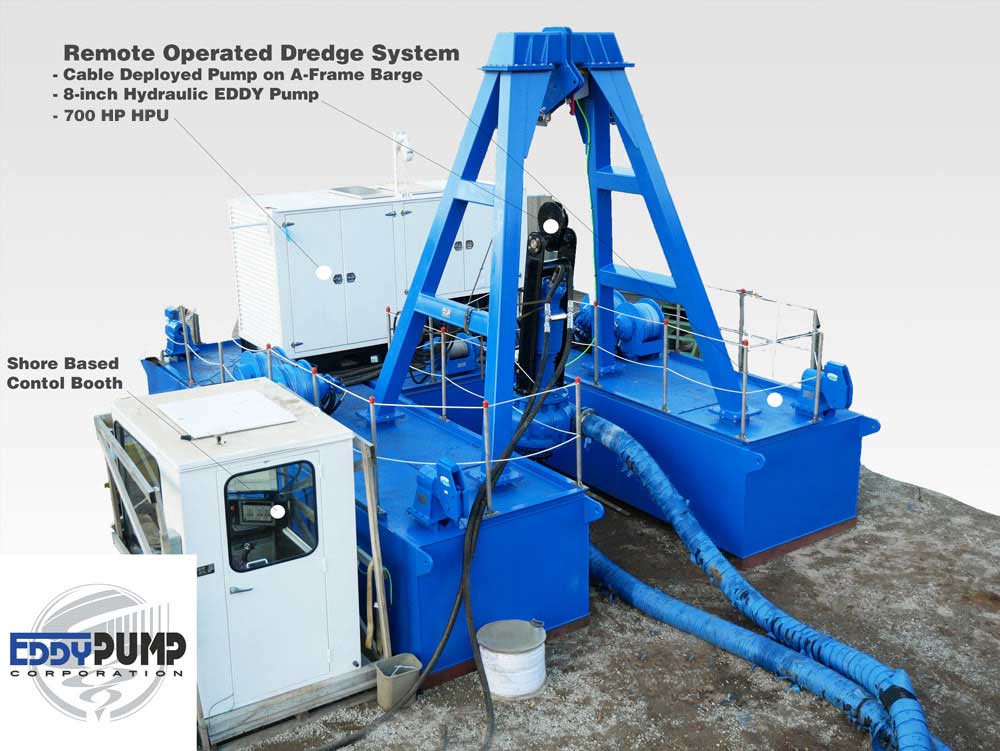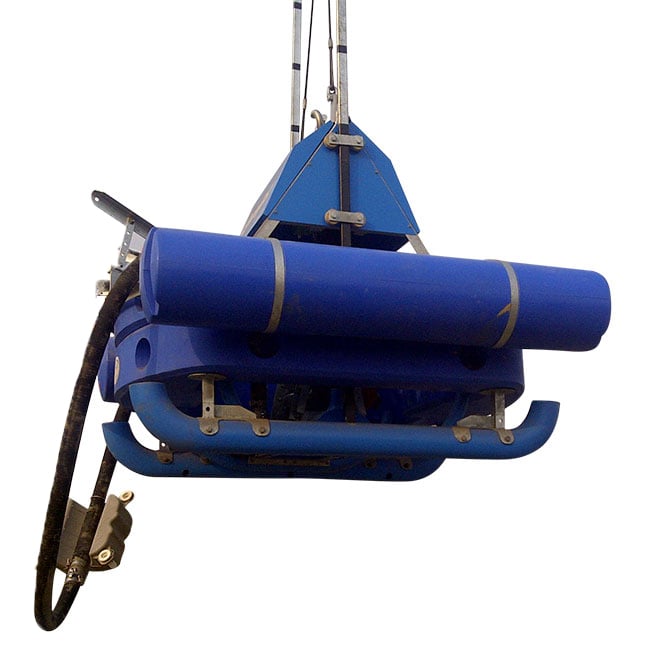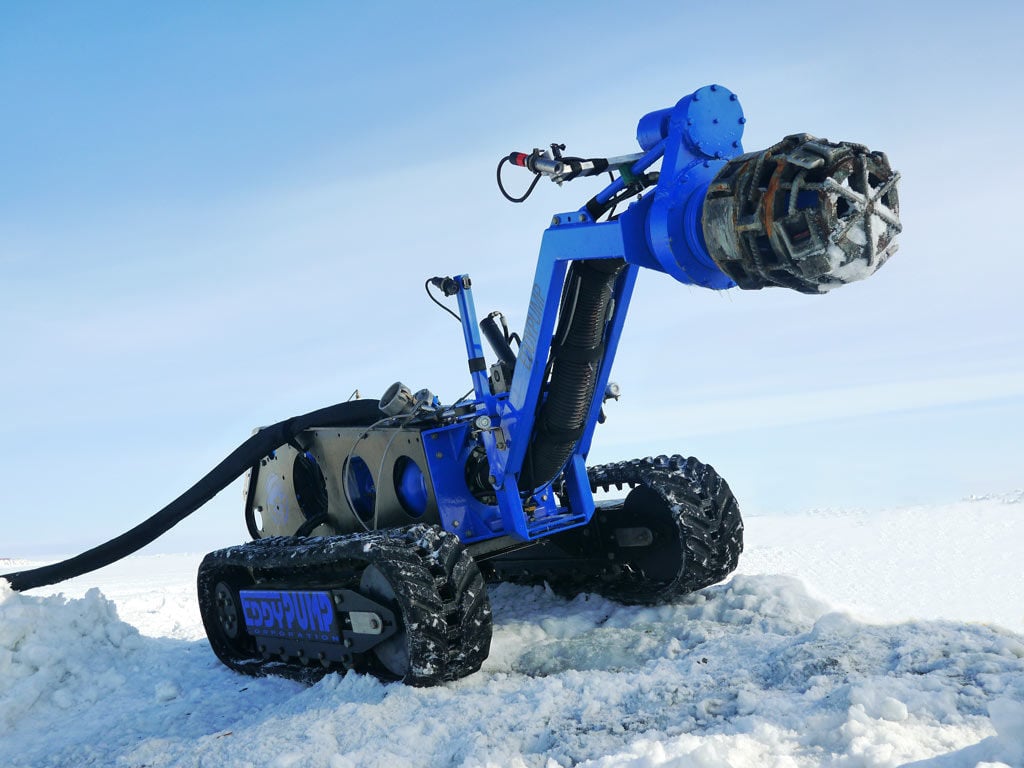EDDY Autonomous Dredge System is remote operated and unmanned. This state of the art dredging system is unique to the market and improving the process for high solid pumping.
This dredging system can move slurry, sludge and high solids up to 4000 GPM at over 400 ft of head. Our patented EDDY Pump technology outperforms all centrifugal, vortex and positive displacement pumps in a variety of the most difficult pumping applications.
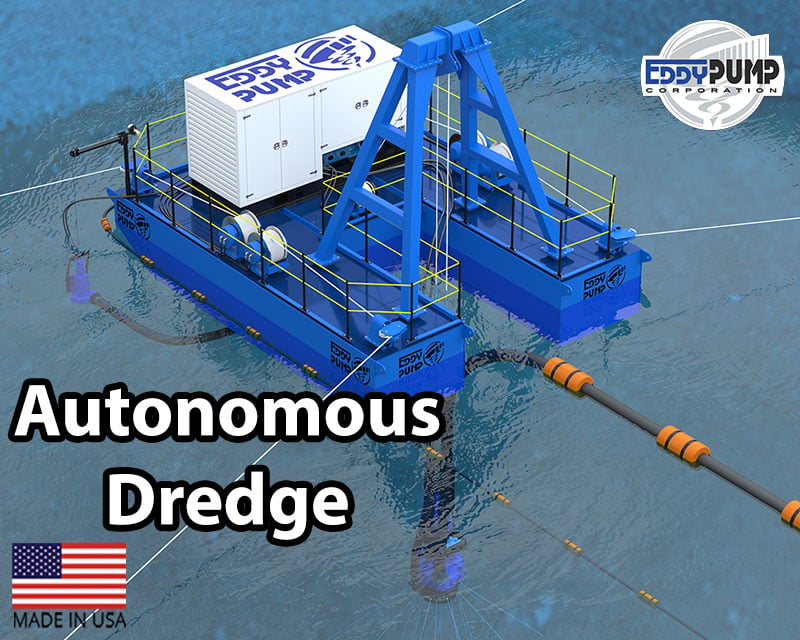
The Autonomous Unmanned Dredge
This semi-automated dredge has a footprint of only 650 sq. ft. By anchoring 3 to 4 cables on land, the system can effectively dredge a large area without any onboard crew.
The dredge uses an array of electronic instrumentation to control the four onboard winches to literally pull itself along a predefined dredging path, raise and lower the pump, and regulate pump RPM. Due to the cable-based pump deployment the dredge can up to 100 ft deep. All while featuring a non-clogging design to minimize machine downtime.
HD10000 Pump
At the heart of the Autonomous Dredge is the 10 inch EDDY Pump, the HD10000. This pump can move slurry up to a rate of 4000 GPM at over 400 ft of head. All EDDY Pumps are uniquely engineered to outperform their competitors. Unlike alternative pumps, the EDDY Pump is optimized for:
– High Production
– High Concentration Solids
– High Viscosity and Specific Gravity Fluids
– High Abrasive and Corrosive Materials
– Low Ownership Cost
We are one of the few companies who manufactures both our pumps and dredging equipment to ensure optimal support.
All dredges use our industrial EDDY Pumps, with this autonomous system powered by a 4, 6, 8, 10 or 12-Inch EDDY Pump, to match your project production requirements.
EDDY Pump has been bringing new innovative solutions to the aging dredge industry since 1984. Building on their popular autonomous submersible dredge technology, EDDY Pump engineers have developed yet another groundbreaking product, the Autonomous Dredge System.
Dredging Equipment
All EDDY Pump dredges use our proven USA Built industrial pumps.
The core of this design is the patented EDDY Pump technology. The design redefines the pumping industry by being the only pump that utilizes the principles of a tornado to create a synchronized eddy current. This pump is not a centrifugal, positive displacement or vortex pump, but instead the most highly efficient high solids and high specific gravity pump on the market. This translates to the ability to pump higher percent solids of material and capture the heavy specific gravity gold.
Autonomous Dredge Data Sheet (PDF)
To learn more about the technology behind our pumps continue reading more HERE.

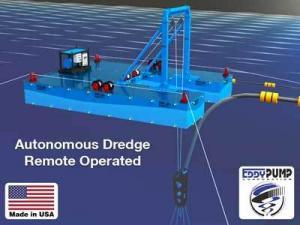
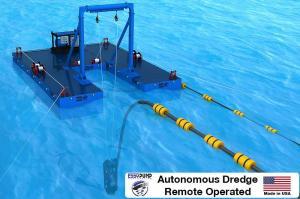
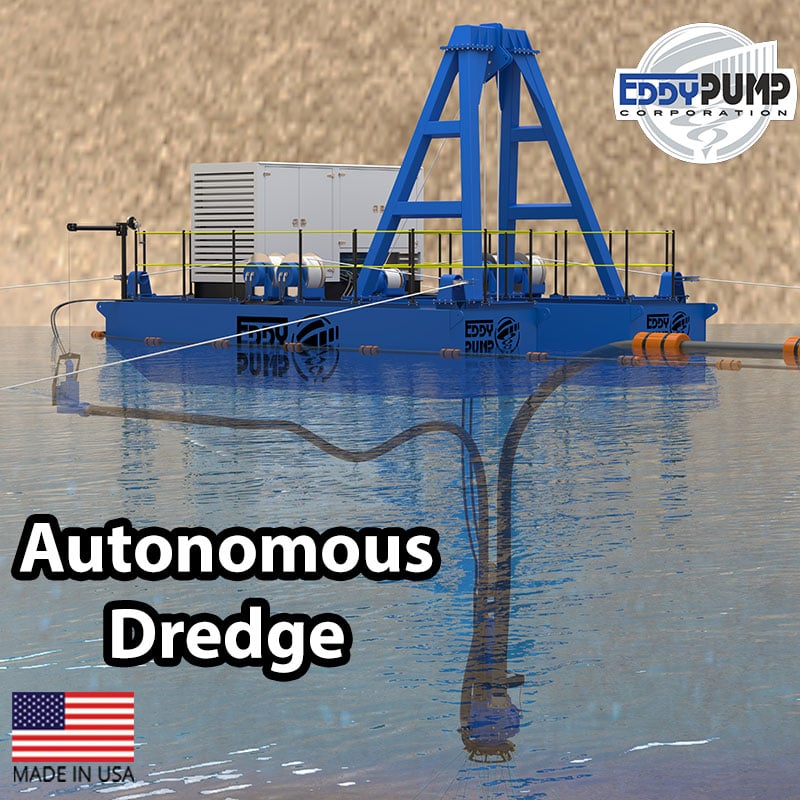
Features and Benefits
Autonomous Unmanned Dredge
EDDY Pump Advantages
- Remote Operated, Autonomous Dredge
- Non-Clog, High Viscosity, High Specific Gravity, High Abrasives, Low pH Pumping Design
- 40-70% Solids Pumping by Weight
- Ability to pump objects of up to 12-inches in diameter
- 100% American Built
- State-of-the-Art Research and Development Facilities on site
- Easily process rags, string, rocks and foreign objects
Pump Features
- Non-Clogging Design
- High Solids Handling
- High Viscosity and Specific Gravity Handling
- High Abrasives Handling
- No Critical Tolerances
- Low Maintenance
- Minimal Downtime
- Low Ownership Costs
Call for Sales or Support
Call 619-404-1916
ALTERNATIVE DREDGES
Specialized Equipment To Fit Your Dredging Needs
Dredge Sled
The Dredge Sled is highly engineered for submersible dredging with the ability gently slide along the bottom to pump highly viscous or abrasive material, sludge, muck, paste, high solids, and other harsh pumping applications. Learn More…
Subdredge Submersible ROV
Auger Dredge – Remote Operated
Talk to Engineering or Sales
If you need help with Pump Selection, Sales or Engineering Support
Call 619-404-1916
BARGE DREDGE FAQs
What is a barge dredge?
A barge dredge is a type of dredging equipment mounted on a barge platform designed for excavating, transporting, and discharging sediments, soils, or other materials from underwater or below-ground locations. It combines a barge’s mobility and stability with specialized equipment’s dredging capabilities to perform various operations.
How does a barge dredge work?
A barge dredge typically utilizes a dredging pump, suction system, and equipment mounted on the barge platform to excavate materials from the seabed, riverbed, or other water bodies. The dredged material is transported through pipelines or discharge hoses to designated disposal areas or processing facilities.
What are the components of a barge dredge?
Components of a barge dredge may include:
- Dredging pump
- Suction head or cutter head
- Dredge pipe or discharge hose
- Barge platform
- Hydraulic or mechanical systems
- Control and monitoring equipment
- Navigation and positioning systems
What types of dredging operations are suitable for barge dredges?
Barge dredges are suitable for various dredging operations, including:
- Harbor dredging
- Channel maintenance
- River dredging
- Coastal protection
- Land reclamation
- Environmental Remediation
- Aggregate mining
What are the advantages of using a barge dredge?
Advantages of using a barge dredge include:
- Increased mobility and flexibility
- Ability to access shallow or remote areas
- Higher dredging capacity and efficiency
- Reduced environmental impact
- Versatility in handling different types of materials
- Cost-effectiveness for large-scale dredging projects
How is a barge dredge transported and deployed?
Barge dredges can be transported to the dredging site via tow vessels, tugboats, or self-propelled barges. Once at the site, the barge is anchored or moored in position, and the dredging equipment is deployed into the water to commence dredging operations.
What are the size and capacity range of barge dredges?
Barge dredges come in various sizes and capacities to suit different project requirements. They range from small, compact barges equipped with portable dredging equipment to large, ocean-going barges capable of handling significant volumes of material.
Are barge dredges customizable to specific project needs?
Yes, barge dredges can be customized and configured to meet specific project requirements, including dredging depth, material type, flow rates, and environmental conditions. EDDY Pump offers customizable barge dredge solutions tailored to the needs of each dredging project.
What maintenance is required for barge dredges?
Maintenance for barge dredges includes routine inspections, servicing of dredge components, cleaning pipelines, and hoses, lubricating moving parts, and monitoring of hydraulic or electrical systems. Proper maintenance ensures optimal performance and prolongs the operational lifespan of the equipment.
How can I determine if a barge is suitable for my dredging project?
To determine if a barge dredge suits your project, consider factors such as dredging site conditions, water depths, material characteristics, project timeline, budget constraints, and environmental regulations. Consulting with dredging experts can help assess project requirements and recommend suitable equipment and solutions.
How does a dredging barge work?
A dredging barge works by utilizing specialized dredging equipment mounted on the barge platform to excavate sediments, soils, or other materials from underwater or below-ground locations. The dredged material is transported to designated areas using pipelines or discharge hoses.
What is the purpose of dredging?
Dredging primarily removes sediments, debris, or obstructions from waterways, harbors, ports, channels, and other aquatic environments. It helps maintain navigable water depths, improve waterway access, prevent flooding, and support environmental restoration and construction projects.
What is dredging in shipping?
In shipping, dredging refers to maintaining navigable channels, harbors, and ports by removing sediments and maintaining appropriate water depths to accommodate ships and vessels. Dredging in shipping is essential for ensuring safe and efficient maritime transportation.
What is a dredging boat called?
A dredging boat is commonly referred to as a dredger or dredging vessel. These specialized vessels have dredging equipment such as pumps, suction heads, and cutter heads to perform excavation and dredging operations in water bodies.
What is a barge used for?
A barge is a flat-bottomed boat or vessel used for transporting cargo, equipment, or materials on inland waterways, rivers, and coastal areas. A barge is often used to support dredging equipment and perform dredging operations.
How is dredging done?
Dredging is typically done using specialized equipment such as dredgers, pumps, and pipes. The dredging equipment excavates material from underwater or below-ground locations, and the dredged material is then transported and discharged to designated areas for disposal or further processing
What are the three significant effects of dredging?
The three significant dredging effects include:
- Alteration of aquatic habitats and ecosystems
- Changes in water quality and sedimentation patterns
- Potential impacts on marine life and biodiversity
Where is dredging most commonly used?
Dredging is most commonly used in coastal areas, ports, harbors, navigation channels, rivers, inland waterways, and construction projects involving land reclamation or infrastructure development near water bodies.
What are three reasons for dredging?
Three reasons for dredging include:
- Maintaining navigable water depths for shipping and maritime transportation
- Preventing flooding by removing sediment buildup and obstructions from waterways
- Environmental remediation and habitat restoration projects to improve water quality and ecosystem health
What are the disadvantages of dredging?
Disadvantages of dredging may include:
- Disruption of aquatic habitats and ecosystems
- Potential release of contaminants and pollutants from dredged material
- Impact on marine life and biodiversity
- Cost and environmental regulations associated with dredging operations
What are the two main types of dredging?
The two main types of dredging are mechanical dredging and hydraulic dredging. Mechanical dredging involves using equipment such as dredgers, excavators, or draglines to physically remove material, while hydraulic dredging utilizes pumps and suction systems to transport sediments.
What are the risks of dredging?
Risks of dredging may include:
- Accidental spills or releases of contaminants during dredging operations
- Damage to sensitive habitats, ecosystems, or cultural resources
- Potential impacts on water quality, sedimentation patterns, and aquatic life
- Challenges associated with managing and disposing of dredged material in an environmentally responsible manner.

